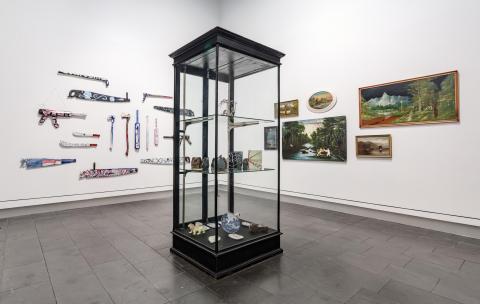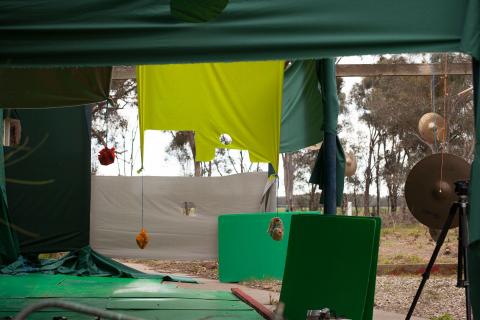Cruisings of the recent TarraWarra Biennial
Already by the time this text is published and in circulation, there will be numerous conversations and interventions coursing around the current TarraWarra Biennial: Endless Circulation. Multiple readings will have permeated across the formal and the vernacular—from published reviews to lectures on gossip and the way the body traces the consumption of bathroom perishables. Such a plurality of reading and knowledge production is enabled by the expansive curatorial premise of this iteration of the Biennial. Through a collaborative approach with the Melbourne based art journal Discipline, this years event presents itself in the broadest sense as a publication, defined in part by the construction of ‘a space of conversation which beckons a public into being’. (1)
As a survival strategy, biennials are contingent upon their ability to adapt to new ways of presenting and disseminating information. As a mere pragmatic factor of geographic limitations, experiential appendages such as expanded forms of publication and satellite events have become staple components for delivering a biennial’s rubric, in the aim of reaching a broader public. Key examples of this include the recent Sydney Biennale’s ‘Bureau of Writing’ and dOCUMENTA (13)’s writing residency ‘Chorality, On Retreat: A Writers’ Residency’, situated from inside a Kassel restaurant. For its fifth iteration since inaugurating in 2006, the dyadic TarraWarra event focuses on the push-pull tendencies of biennials to gather and concentrate alongside the modus operandi of publications to disperse and propagate. It is through these tendencies, in concert with its eye to the past and the future, that the event finds its pulse. In response to the regional locale of the TarraWarra Museum in the Yarra Valley an hour and a half’s drive from Melbourne, this year’s event hosted a series of roving city-based public lectures. In lieu of the many ‘places’ that biennials seek to inhabit, this years’ program migrated across formats of exhibition, performance, print, spoken discourse, material intervention and exchange economies.
In addition to Ryan Presley’s Blood Money (2014) which sees the artist create an Aboriginal Australian currency commensurate to Australian dollars (made available for purchase on a 1:1 ratio in the gallery foyer), Debris Facility have produced a collegiate of restroom products made of organic and chemical substances including activated charcoal soap and chameleon iridescent pigment. By their perishable status, the replenishing of these materials signifies a reiterative, circulatory capital directly proportionate to user use value.
Hinged on passages of return, the exhibition’s thematic appeal to forms of endless circulation centres largely on Australia’s colonial history and the intimate repose of breath required to oxygenate the enduring work of decolonisation. Heightened through an experience of entering the gallery whilst listening to Saskia Doherty’s silicate silicate silicate (2015)—a perfunctory 10-minute looped audio work accessible through iPods and headphones—this roving sound installation cum gallery audio tour attends to the endless cycles of breath and the undercutting of bodily expenditure present in the continuous vocal choreography. ‘Onion skin paper’ and ‘illustrated maps’ are just some of the fragments spoken in accompaniment of heavily laboured inhalations. Doherty’s attendance to self-erasure through expenditure and the clutchings of the breath display well alongside Robert Andrew’s time-based, three-part mechanical erasure apparatus Transitional Text – Buru (2016), in which reversed whitewashing occurs via erratic bursts of water to reveal a layer of rich ochre and the word BURU (the Yawuru word for ‘country’).
A further series of call-and-responses are established between various works situated within (and outside) the small, intimate museum spaces. Some of the more obvious examples of spatial and dialogic mirroring of works include Wrong Solo’s Wrong Solo presents Destine Variations (2016), another kind of co-opted gallery tour that functions as a site of ‘cruising’ (a code word in gay sub-culture which references an overtly sexualised form of spatial navigation). Beyond the ‘cruises’ enacted in the first week of opening, viewers are invited to go behind a pair of digitally printed curtains to engage their own re-reading of various scripts as part of the performances. Included in the suite of laminated placards are instructions for breathing exercises as well as noted reference to a 2013 work Forwards Forwards. On the opposite side of the room, we find Helen Johnson’s Empire Play (2016), a two-dimensional painting in which the colonial subject matter central to Johnson’s practice is destabilised through a series of visual and discursive juxtapositions. Within the picture plane, the political regime of colonial servitude rubs up against cartoonish conviviality, fat meeting lean in form and contours of painted dramaturgy. On closer inspection, we are invited—much like with Wrong Solo’s participatory reading exercise—to indulge in the marginalia of the painting’s verso, which presents as a series of subjective notes, perhaps scribbled in context of the work’s dominant/recto narrative:
Homesickness
feels like a
lack of affective
possibility in
everything that
one experiences
Positioned as they are between three key indigenous works—Andrew’s Transitional Text – Buru, Vincent Namatjira’s superb portraits of Australian prime ministers in Cook’s Dinner Party (2015) and Wukun Wanambi’s ceremonial media installation Nhina, Nhäma, Ga Nyäma (Sit, Look, and Listen) (2014)—a somatic reading-between-the-lines of otherwise performed two-dimensional narrative discourse is afforded, suggesting that the body of archival memory and agency is in fact our own.
A walk through the primary exhibition leads to the north gallery and a showcase of Christopher L G Hill’s artist-facilitated biennial—one of a series of DIY variations to the international biennial structure; a series he commenced in 2008. Existing as a subtext to the primary metanarrative of the biennial event (itself situated as what Jean-François Lyotard termed the petits récits: a shift towards modest, local narratives as a way of throwing grand universal narrative claims off course), circulation appeals here in one respect to the politics of friendship. Itself a site of economic contingency, friendship is positioned as a space for anti-capitalist exchange and is activated through a fraternity of cyphers and in-jokes for the initiated. Ironically, the axiom of friendship is here offset (substantiated?) by the commodification of Hill’s ongoing publication Endless Lonely Planet. This ‘other’ biennial presents as both parasitic to and sustained by the more formal biennial composition, further expounding the co-dependency of network structures. With reference to endless circulation however, friendship in the art world has the tendency to furnish a stuffy rather than altogether refreshing air of ventilation. Thankfully, across the entire event there is enough conversation between strangers to upend the likelihood of parochialism.
Further along, past Masato Takasaka’s maximalist installation in homage to the artist’s repeated reworking of elements of his own practice, the gallery returns upon the experience of a literal figure eight. With a re-arrival at the intersection of three key time-based works—Bianca Hester’s Constellating bodies in temporary correspondence (2015-16), Biljana Jancic’s Conduit (2016) and Alicia Frankovich’s World is Home Planet (2016), the experience of doubling back onto the works—themselves having travelled through passages of sight, sound and smell in the time taken for us to re-arrive—denies us of any single, prescriptive encounter. This doubling back reinforces the tendency for a multiplicity of entry into the biennial at large; through various passages of return (whether present in the content of the works or the way we interact with them), we are afforded more chances at re-reading, or more precisely, more opportunities for slippage.
It is in the conversations between the more peripatetic and seemingly minor material interventions (the bathroom products of Debris Facility’s Excipient (2016-2022) and Doherty’s voluntary audio work for example), alongside the more candid textual topos of Eugenia Raskopoulos’ routreroute / rootreroot (2016) and Vernon Ah Kee’s authorsofdevastation (2016) that the most cogent inflection upon this event occurs. That we might miss the gold embellishments on the gallery door, the contraband currency at the counter, or every lecture of the public program, speaks directly to the multiscalar improbability of ‘reading’ such a project like this in its entirety. It says something about the increasing appeal of reiterative forms and sites of circulation across registers, for the ways in which a public might get in to such a conversation, and how we can reconsider our focus on the interstitial pauses between editions.
(1) Publication Studio, 2009, http://www.publicationstudio.biz/about/









